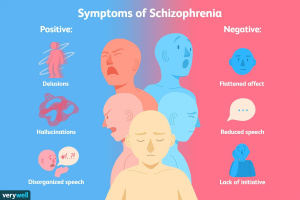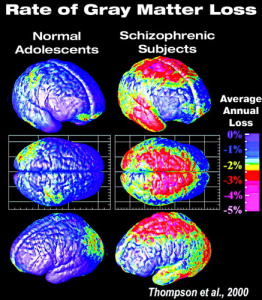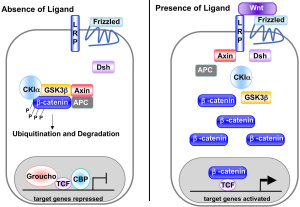Schizophrenia is a debilitating disease that effects 24 million people worldwide, 2.8 million of those people being in the United States. Schizophrenia is a disease that affects how a person, thinks, feels, and behaves. There are people, just like you and me, that are struggling with hallucinations, delusions, disorientated thinking, and impaired daily function.
 When diagnosing schizophrenia, there are two sets of symptoms that are quite distinguishable. A psychologist will be looking for positive and negative symptoms. Positive symptoms include hallucinations, delusions, and disorganized speech. Negative symptoms include flattened affect, reduced speech, and lack of initiative.
When diagnosing schizophrenia, there are two sets of symptoms that are quite distinguishable. A psychologist will be looking for positive and negative symptoms. Positive symptoms include hallucinations, delusions, and disorganized speech. Negative symptoms include flattened affect, reduced speech, and lack of initiative.
It has been proposed that schizophrenia might develop sooner than we have previously seen. Most people get diagnosed in adolescence, but it is hypothesized that abnormalities could begin in utero along with early environmental influences such as infection.
Changes in the Brain: Physical and Molecular
There are many changes that can be seen in the brain when looking at people diagnosed with schizophrenia. Smaller total volumes of brain tissue and less gray matter. Schizophrenia affects many adolescents and young adults, so the image to the right shows the rate of gray matter loss in schizophrenic adolescents. It can be seen that there is a faster rate of loss within the parietal (top) and temporal (side) parts of the brain.
 Those are some physical changes in the brain that can be seen by imaging. There are molecular changes that are happening in the brain that can’t totally be seen. Schizophrenia can be linked to the Wnt pathway, which with more research, can help lead to better treatments.
Those are some physical changes in the brain that can be seen by imaging. There are molecular changes that are happening in the brain that can’t totally be seen. Schizophrenia can be linked to the Wnt pathway, which with more research, can help lead to better treatments.
Overactive dopamine is binding to its receptors (D2) which inhibits the Akt enzyme. The inhibition of this enzyme will in turn decrease the inhibitory phosphorylation of GSK3-beta. If GSK3-beta is not inhibited, it will remain a destruction complex in the Wnt pathway. With this complex still in place, beta-catenin will continue to break down and gene transcription does not happen. Without gene transcription, genes important for neural development will not be expressed. When these genes are not expressed, abnormal functioning and development occurs which can ultimately lead to schizophrenia.
Schizophrenia is a complex disease that is very difficult to study and research. It is hard to model schizophrenia in a lab which is why the treatment options and research is so slow. Finding out the that Wnt pathway is involved in schizophrenia is a big advancement in the etiology and treatment of this disease. With new genetic findings and animal and human stem cell models, there will be the ability to gain a deeper understanding of all neuropsychotic disorders not just schizophrenia.
How to Gain Empathy for the Mentally Ill
Mental illness can change the course of someone’s entire life. Even with treatment, their life will be filled with psychiatrist appoints, therapy sessions, pharmacy visits, and people treating them differently. The negative stigma around mental illnesses has gotten better over the years, but there is always room for change and improvement.
People with mental illnesses cannot help it. It is not their fault, and it never will be. They can barely get the help that they need so we do not need to add to the stress. I think that education and advocation is something every person should care more about when it comes to the mentally ill. Taking the time to research a mental illness or asking respectful questions or standing up for people with mental illness when they are not able to stand up for themselves is essential.
There are many TV shows, movies, and books that depict the life of those with mental illnesses. While these can bring awareness to living with mental illnesses it is important to remember that these are more than likely dramatized and do not show accurate depictions of what it is really like to live with these types of illnesses.
 One of the best books that I have read that accurately shows schizophrenia and what it is like is the book called Challenger Deep by Neal Shusterman. This book follows a young boy who has schizophrenia and his daily struggles. We get a glimpse into the mind of someone with schizophrenia and this sort of thing hasn’t been done too often.
One of the best books that I have read that accurately shows schizophrenia and what it is like is the book called Challenger Deep by Neal Shusterman. This book follows a young boy who has schizophrenia and his daily struggles. We get a glimpse into the mind of someone with schizophrenia and this sort of thing hasn’t been done too often.
References:
Jodi Clarke, M. A. (2022, May 20). Signs and symptoms of schizophrenia. Verywell Mind. Retrieved February 19, 2023, from https://www.verywellmind.com/what-are-the-symptoms-of-schizophrenia-2953120
NEALSHUSTERMAN. (2020). Challenger deep. Amazon. Retrieved February 19, 2023, from https://www.amazon.com/Challenger-Deep-Neal-Shusterman/dp/0061134147/ref=sr_1_1?crid=1H3WVMZLS747J&keywords=challenger%2Bdeep&qid=1676832807&sprefix=challenger%2Bdeep%2Caps%2C185&sr=8-1
Singh, K. K. (2013). An emerging role for Wnt and GSK3 signaling pathways in Schizophrenia. Clinical Genetics, 83(6), 511–517. https://doi.org/10.1111/cge.12111
Wnt signaling*. WormBook Header Image. (n.d.). Retrieved February 19, 2023, from http://www.wormbook.org/chapters/www_wntsignaling/wntsignaling.html
